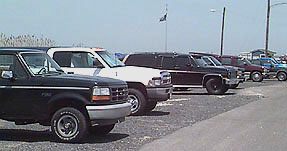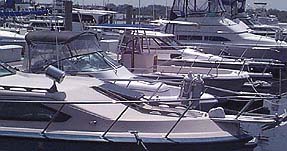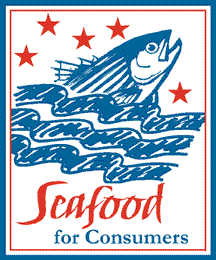
Number 5
February 9, 1999

 |
 |
THE NEW CONSERVATIONISTS
"Conservation" is the controlled use and systematic protection of natural resources
At the end of the 19th and into the early 20th centuries people of the stature of John Muir, Aldo Leopold and Henry Beston were redefining the word "conservation" and establishing a new, and at the time revolutionary, way of thinking about humankind and our relationship to the natural world. In reading Leopoldís A Sand County Almanac, Bestonís The Outtermost House or in contemplating the thousands of square miles of wilderness that are an important part of our heritage thanks to Muirís unique vision, it is impossible to imagine people with lives more in tune with the natural world.
Anyone recently involved in fisheries issues canít help knowing that
the torch they lit has supposedly been passed down to modern self-described
"conservationists" who only a few years ago were just people whose hobby
was catching fish or whose businesses involved catering to those hobbyists.
Today these people, who weíll call New Conservationists, band together
in "conservation" organizations and actively - and sometimes successfully
- pursue political agendas ostensibly based on the proud legacy of those
men who created the conservation movement. But letís take a look at how
in tune these New Conservationists might be with the conservation ethic
that Muir and Beston and Leopold so successfully established.
One of the easiest ways to recognize a New Conservationist is to identify the vehicle he or she is driving. The sport utility vehicle is the New Conservationistís hands down favorite. The four wheel drive pickup truck is a close second. Whichever the choice, it will probably be festooned with racks to proudly display fishing poles and ice chests. If a vehicle weighs several thousands of pounds more than it has to, if it gets less than half the gas mileage that it could, if it has four wheel drive, big knobby tires with raised lettering, and a trailer hitch on the back, thereís a good chance thereís someone driving who thinks of himself as a conservationist. If the truck or SUV is parked in a garage, driveway or parking lot located on what used to be a salt marsh or other coastal wetland, the chances are even greater.
Where this sport utility vehicle or other vehicular behemoth is being
driven is another indication of whether a New Conservationist is the owner.
If itís up and down the beach - something that would undoubtedly make Henry
Beston throw up his hands in bewilderment but seems to be the primary activity
of many of the New Conservationists - or to the closest marina or boat
launching ramp, you can be almost totally assured that the driver and passengers
are basking in the glow of the conservationistís torch. And basking in
multi-speakered stereo, air conditioned comfort at ten or fifteen miles
per gallon.
 |
 |
|
|
in Barnegat Light, NJ |
When reaching the marina or launching ramp, what is our boat-based New
Conservationist most likely to do? Probably climb into a fiberglass craft
that might well last until the next ice age, crank up the one or two -
or more, if we can actually believe what we see in boating magazines -
100+ horsepower outboard motors, and go roaring off at 40 mph in pursuit
of the "fish of the day," leaving behind a remembrance of his passing in
the form of a petrochemical slick on the water and a cloud of haze in the
air [![]() for
a discussion of possible impacts of recreational boating]. Meanwhile, back
on the beach his land-based compatriot is cruising up and down the strand
in his quest for fish, turning areas that were once the exclusive domain
of sand pipers, piping plovers, frisbee tossers, sun bathers and nesting
turtles into a slower-speed version of the freeways back home.
for
a discussion of possible impacts of recreational boating]. Meanwhile, back
on the beach his land-based compatriot is cruising up and down the strand
in his quest for fish, turning areas that were once the exclusive domain
of sand pipers, piping plovers, frisbee tossers, sun bathers and nesting
turtles into a slower-speed version of the freeways back home.
Up until now it might be somewhat difficult to understand how these
supposed disciples of Muir, Beston and Leopold think they are carrying
on the conservationist tradition. But, on the fishing grounds once theyíve
caught and killed all the fish they want to take home to either eat or
hang on the wall as "trophies," they stop throwing their catch into their
buckets or coolers and begin practicing whatís known as "catch and release."
Catch and release is a process involving hooking a fish, allowing it to
struggle at the end of the line until exhausted enough to be reeled in,
taking it off the hook and putting it back in the water, supposedly to
live to "fight another day." This is done until theyíve fully satisfied
their urge to fish or the fish stop cooperating and is the primary way
the New Conservationists think they conserve. (We must note here that catching
and releasing isnít inflicted only on the fish the anglers donít want to
eat or to hang on their walls. Fish are also caught and released because
they are too large, too small, out of season or of the wrong species to
be legally kept.)
Unfortunately, many of the fish caught and released by New Conservationists - or by anyone else, for that matter - donít live long enough to fight on that other day. Research indicates that a significant percentage of released fish donít survive this kind of conservation, in short order becoming crab, shark or seagull food. While the New Conservationists consider any fish not remaining belly-up at release a healthy and happy survivor, this isnít necessarily so. Delayed catch and release mortality, which can reach 20 or 25 percent, has real conservationists rightfully concerned.
Catching and releasing is one of two activities that distinquishes New
Conservationists. The other, of course, is condemning commercial fishermen
at every opportunity for catching and keeping - and providing to consumers
- those same fish the New Conservationists want for themselves. Try as
they might to cloak it in self-righteous rhetoric, the New Conservationistís
brand of "blame someone else, Iím not the problem" conservation is nothing
like the real thing. But theyíve found that itís too hard to look in the
mirror - those big SUVs and fancy boats must be tremenduously appealing
to them - and easy to point a finger at the other guy. The first "other
guy" is a commercial fisherman but behind him are millions of seafood consumers.
| CONSERVATION QUESTION: Is it better to catch and keep two or three fish for personal consumption then go home and wax the SUV, or to catch and release twenty or more, knowing that a significant proportion arenít going to "live to fight" another day? |
Please Note: We know some recreational anglers who are as concerned with the "footprints" they themselves leave in the natural world as those that are left by others. True conservationists, they are environmentally aware and responsible and their lives reflect it. These comments arenít directed at them. Their houses are in order and they arenít built of glass.
FISHING VESSEL SAFETY
The tragic loss of ten crew members of four ocean clamming vessels that sank in a two week period has riveted attention on the issue of safety in the commercial fishing fleet. Both the U.S. Coast Guard and the National Transportation Safety Board are investigating these losses, the first in the clamming fleet since 1992. (Note: While results wonít be available until the Coast Guard investigation is much further along - hearings are still being conducted - Master Chief Dave English is available to discuss fishing vessel safety. He can be reached at the Coast Guardís Philadelphia office at 215 271-4869.)
Without question, commercial fishing is a dangerous profession. The ocean can be a sometimes inhospitable and occasionally dangerous workplace and the periods of inhospitality or danger arenít always predictable. Stringent federal safety requirements recognize and all the people who work on commercial fishing boats realize this. (the Commercial Fishing Vessel Safety Act of 1988 - 46CFR28 - that established industry safety standards is described in the box below.
![]() will
take you to a page on this site with the "Reguirements For All Vessels"
section..
will
take you to a page on this site with the "Reguirements For All Vessels"
section..
![]() will
take you to the Code of Federal Regulations search page (enter "46CFR28"
and the subject area you are interested in).
will
take you to the Code of Federal Regulations search page (enter "46CFR28"
and the subject area you are interested in).
As they do in every workplace, accidents happen on commercial fishing
boats. When these accidents happen at sea, and when the forces of
nature are stacked against the vessel, the results can be tragic.
|
"According to the National Research Council, the fishing industry is the most hazardous in the United States. Fatality rates for commercial fishers are significantly higher than any other industry. The commercial fishing industry comprises about 50 percent of the employment in the entire maritime industry. Of the 140,000 commercial vessels regulated by the Coast Guard, more than 80 percent are fishing vessels. To address and correct the unacceptable safety record of the commercial fishing industry, Congress passed the Commercial Fishing Industry Vessel Safety Act of 1988. In response, the Coast Guard developed regulations which took effect in 1991. The regulations require vessels to carry safety equipment, including lifesaving equipment, survival craft, communications equipment, distress signals, Emergency Position Indicating Radio Beacons, fire extinguishers, emergency alarms and bilge pumps. The new regu-lations also developed guidelines for watertight integrity and stability. The act established a Commercial Fishing Industry Ves-sel Advisory Committee made up of fishers, marine-safety and insurance representatives and safety equipment vendors. The committee meets annually and provides the Coast Guard with recommendations on safety and equipment items. The committee plays a part in the development of realistic regulations. This has fostered greater industry acceptance of the requirements. The core program is a no-cost, no-fault, voluntary dockside safety examination program. Fishers can request a Coast Guard vessel examination to ensure they have the proper types and quantities of safety gear. This is non-adversarial, and the examinations are used as an educational tool, as well as a means to encourage future compliance. The voluntary exams are complemented by the Coast Guardís at-sea law enforcement program. Critical safety items are checked at sea during fisheries law enforcement boardings. Citations are issued for safety deficiencies, and, in more serious cases, vessels may be ordered back to port. The Coast Guardís success has been measured by the steady reduction of commercial fishing deaths since 1992. The combination of regulations, industry awareness and participation is helping make a dangerous occupation safer." (from "Protecting Americaís Fisheries" by LT John Garofalo in the May, 1998 issue of Coast Guard) |

![]()
| FishNet USA is distributed to over 1500 elected and appointed officials, media representatives, individuals and organizations with an interest in fisheries issues via fax and email. It is supported by Atlantic Capes Fisheries, the Fishermenís Dock Cooperative, Lundís Fisheries, Export, Inc., Agger Fish Corp., the National Fisheries Institute and Viking Village Dock |